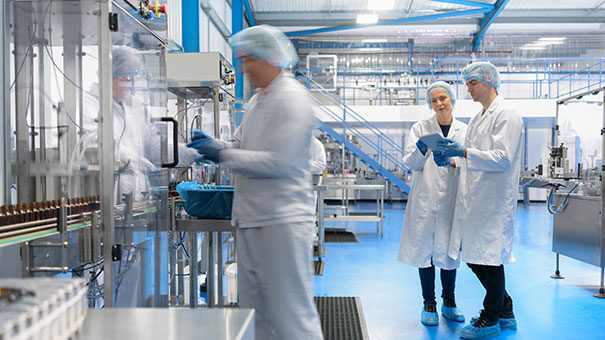Table of Contents
The pharmaceutical manufacturing industry is a unique environment in a number of ways, but especially when it comes to ergonomics and musculoskeletal disorder (MSD) risk. There are the typical manual material handling (MMH) tasks like lifting and moving product in a warehouse, but many injuries in this industry are actually from lab tasks. And while the traditional MMH tasks can be assessed for MSD risk and changes can be easily made, the lab tasks don’t get the same type of attention and action.
MSD Risks Unique to Pharmaceutical Manufacturing
The most common issue in the pharmaceutical industry is awkward postures. These postures are unique to pharmaceuticals because the industry itself requires a lot of specialized, expensive equipment and machinery, and a lot of cleaning. Many lab researchers and technicians suffer with upper body pain, specifically in the neck, shoulders and elbows, from tasks like working on microscopes that require them to extend their neck for prolonged periods of time or working under a fume hood with their arms extended underneath a plexiglass window.
Oftentimes folks are performing tasks in a full body suit with multiple pairs of gloves, a mask and goggles, which ends up limiting their visibility and control of their body. Imagine trying to reach into a machine to clean it while wearing all that personal protective equipment—you’d end up using some awkward postures to get the job done, however long it took.
These MSD risks can have a significant impact on safety performance. One of VelocityEHS’s customers in the pharmaceutical manufacturing industry found that prior to implementing an ergonomics program, about 50% of their recordable injuries resulted from cumulative trauma and manual material handling incidents. Once the company implemented an ergonomics program, they recorded a significant reduction in overall injury rate.
Hesitations for Developing an Ergonomics Program
Although many lab employees are struggling with various types of discomfort in their work, the pharmaceutical industry faces some specific challenges when it comes to building momentum behind an ergonomics program.
Pharmaceutical manufacturers have the means to design and build unique pieces of equipment, created for specific tasks. This kind of equipment comes at a hefty price, so when employees start developing strains and discomfort from using or cleaning these pieces of equipment, it’s likely that the company might resist making changes to them.
There’s also an issue with how disjointed the pharmaceutical environment is. Tasks are frequently performed in their own room or in isolated spaces within a room, and employees can’t see what the next person is doing or how they’re doing it. Employees working on the same equipment in different rooms can have entirely different work habits because they lack the ability to share best practices. So, when one person develops a strained wrist from the task while the other has found a way around it, the first employee keeps hurting. This adds up to some hesitancy towards the idea of an ergonomics program because the employees don’t have that fundamental experience of standardizing knowledge and understanding ergonomics.
Because the tasks and equipment in the pharmaceutical environment are so specialized, it can also seem more daunting to develop a comprehensive program that accommodates everything. For a manager who doesn’t understand all the tasks that are involved in a process, it’s difficult to develop a program where they can recognize the right metrics or data, and then plan any kind of exit strategy or improvement strategy based on that.
So, how are you supposed to get leaders and employees of the pharmaceutical manufacturing industry to be motivated to make positive improvements with an ergonomics program? Keep reading.
Gaining Pharma Executive Buy-in for an Ergonomics Program
It’s no secret that the pharmaceutical industry has high operating budgets. Sharing the benefit of cost savings from an ergonomics program to gain executive buy-in may not be as motivating as it is in other industries. One of the key components of getting that buy-in are things like specialized certifications and licenses, which can widen their client base or optimize their process, and therefore, increase profits.
Another factor that adds weight when vying for buy-in is that higher turnover can negatively impact product quality. If a company loses ten employees who have expert knowledge of their jobs and must replace them with new employees, the quality and efficiency is going to be lower, at least in the short term. To preserve the high quality of their product, a company needs to preserve their workforce, and they can do that by implementing an ergonomics program that keeps them healthy.
Gaining Employee Buy-in for an Ergonomics Program
When it comes to gaining buy-in from employees, first and foremost, they need to know what it is that you’re doing to help them. They want to know that you won’t be adding to their workload or changing their work in a fundamental way where they’d have to learn something else. Tell them about the benefits that they’ll experience with an ergonomics program, like increased comfort and productivity in their jobs.
It’s also important for employees to see the progress being made outside of their own workspace. They don’t see what the neighbors are doing, or they don’t see what’s happening over in the warehouse, so having a centralized location where they can share progress of actions taken and the improvements made has a big impact.
Let VelocityEHS Help!
Although you have unique challenges in the pharmaceutical manufacturing industry, you can face them with the right solution, like VelocityEHS Ergonomics. Our powerful SaaS system educates and empowers your employees to conduct ergonomics assessments, giving them all the tools they need to maintain a healthy and productive lab environment, and gives you a healthier and more sustainable work environment.

